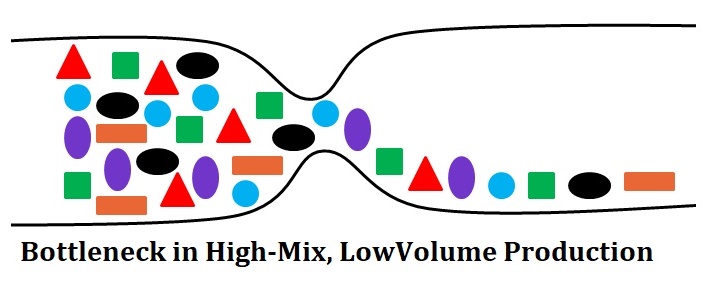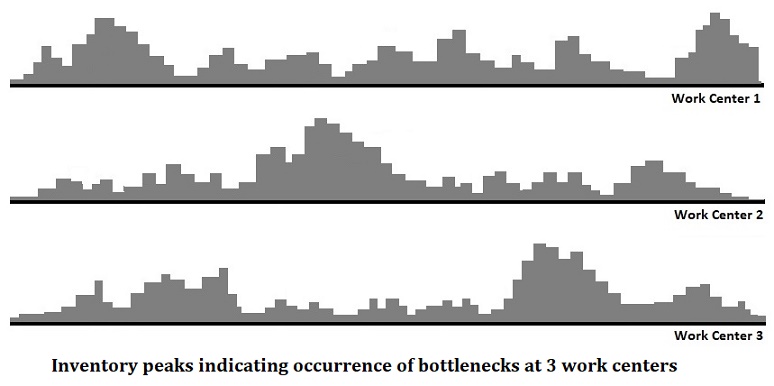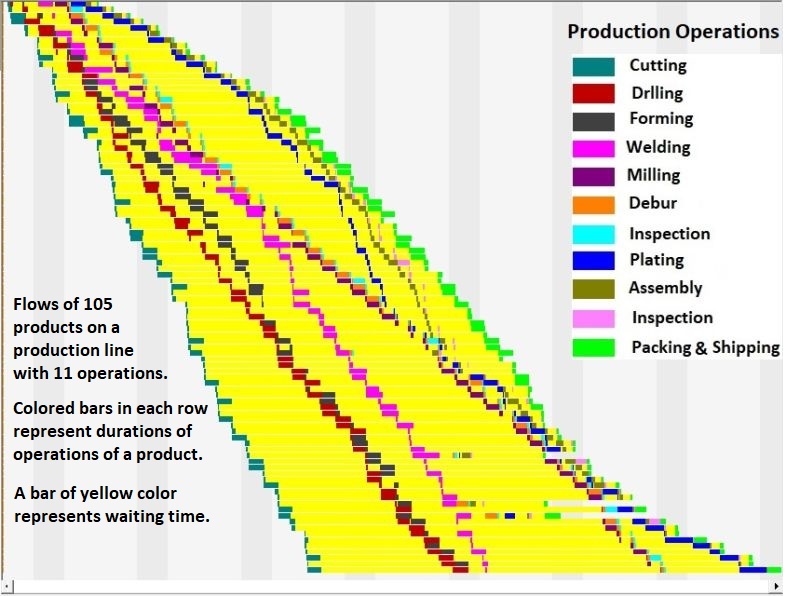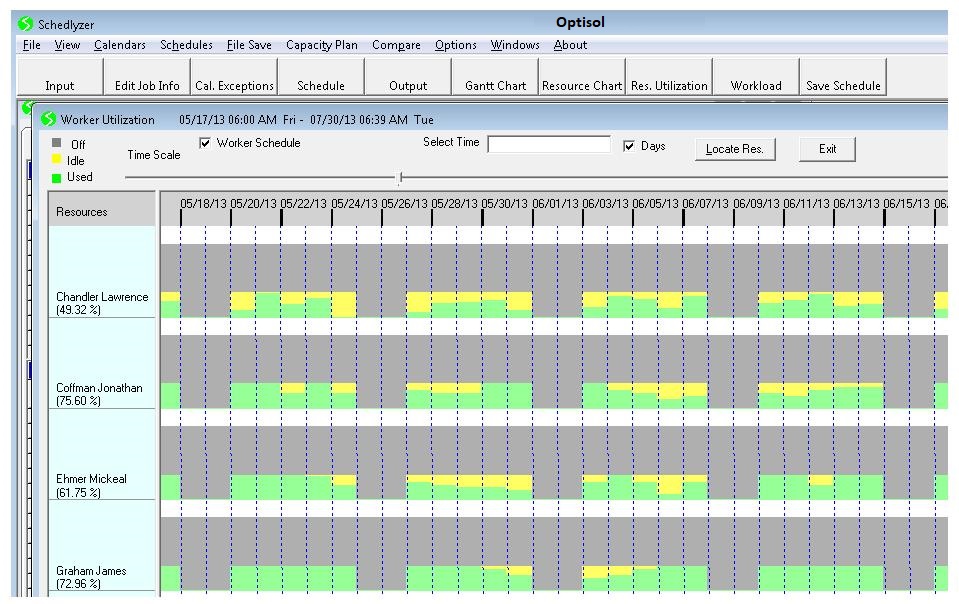Management of Shifting Bottlenecks in High-Mix, Low-Volume Production
In general, a high-mix, low-volume (HMLV) production unit is capable of making a large variety of products. However, demand for most products is infrequent and highly unpredictable  and a due date is normally assigned to each order. Variation in products exists in terms of not only product characteristics but also process requirements of products. Most HMLV manufacturing units are job shops which are small in size and revenue with limited resources. This discussion pertains to bottleneck issues in such units. Shifting bottlenecks occur over time in high-mix, low-volume production due to some factors including:
and a due date is normally assigned to each order. Variation in products exists in terms of not only product characteristics but also process requirements of products. Most HMLV manufacturing units are job shops which are small in size and revenue with limited resources. This discussion pertains to bottleneck issues in such units. Shifting bottlenecks occur over time in high-mix, low-volume production due to some factors including:
- Rapid changes in product mix due to infrequent and highly unpredictable demand for products
- Large known variation in process requirements of distinct products
- Product sequence in production mostly determined by due dates
- Finite capacity of resources
- Rework due to quality issues
- Large, uncontrollable variation in processes
- Major unexpected events like long interruptions in resource availability
.
Adverse Effect of Shifting Bottlenecks:
Shifting bottlenecks disrupt flow of products and consequently have an adverse effect on WIP, production lead times of orders, on-time delivery and throughput. Bottlenecks usually manifest themselves in the form of inventories at work centers. Occurrence of a bottleneck corresponds to  rise in inventory level and conversely, inventory rise at any work center usually indicates a bottleneck occurrence. WIP has large fluctuations and temporary bottlenecks form over time at some work centers due to rapid changes in product mix (in HMLV production). Both outcomes have an adverse impact on lead times, on-time delivery and throughput and the likely delays in product deliveries promote firefighting. Production managers need to control the two outcomes.
rise in inventory level and conversely, inventory rise at any work center usually indicates a bottleneck occurrence. WIP has large fluctuations and temporary bottlenecks form over time at some work centers due to rapid changes in product mix (in HMLV production). Both outcomes have an adverse impact on lead times, on-time delivery and throughput and the likely delays in product deliveries promote firefighting. Production managers need to control the two outcomes.
Difficulty of Mitigating Shifting Bottlenecks:
Efficient production control and management requires identification and mitigation of shifting bottlenecks. Factory people usually try to mitigate them in real time using capacity buffers of resources. The mitigation makes use of options like overtime of worker overtime, extra shift, temporary addition of resources, outsourcing some operations, etc. But, all such options (for bottleneck mitigation in real time) are quite limited in small and mid-sized HMLV units. Prof. Christoph Roser did some research on identification of bottlenecks in production systems. References to his articles are:
- Can you tell your Bottleneck from your Inventory?
- Mathematically Accurate Bottleneck Detection 2 – The Active Period Method.
Unresolved shifting bottlenecks may have an adverse impact on implementation of the theory of constraints (TOC) in HMLV production. They can adversely affect subordination and make Drum-Buffer-Rope (DBR) method of TOC more cumbersome and less effective. They may even keep changing the constraint and make TOC implementation difficult. Buffer management in TOC implementation becomes less effective due to unresolved shifting bottlenecks. TOC does not offer any practical solution to mitigate shifting bottlenecks. Similarly, other methodologies like lean manufacturing, quick response manufacturing and CONWIP are not helpful to deal with unresolved shifting bottlenecks resulting from rapid changes in product mix.
The above mentioned options for mitigation of shifting bottlenecks are sometimes insufficient for total mitigation of shifting bottlenecks. In such cases, production management becomes more efficient if we can predict the occurrence and severity of bottlenecks and perform proactive capacity planning. It also involves releasing material at right times for jobs so that the flow of jobs is not severely affected.
Powerful Scheduling Solutions for Mitigation of Shifting Bottlenecks
If uncontrollable variation and uncertain events in the system are not at a chaotic level, truly powerful scheduling solutions offer a scientific approach that enables us to predict the occurrence and severity of bottlenecks and help with proactive capacity planning. The graphical and numerical output from those solutions help us see in advance the formation of shifting bottlenecks and enable us to proactively mitigate the bottlenecks in the most efficient manner. Nowadays, powerful software solutions for scheduling HMLV production are available to job shops at an affordable price.
Finite Capacity Scheduling Approach to Management of Shifting Bottlenecks
Forward finite capacity scheduling (FCS) identifies shifting bottlenecks in production systems described above. Forward FCS can be described as perfect push system for production control. Although forward FCS is not appropriate for actual production scheduling in general, it can be implemented with the help of FCS software exclusively for the purpose of bottleneck identification.
Schedlyzer is a powerful scheduling software tool that implements forward FCS for bottleneck identification and implements optimal FCS for actual resource-constrained production scheduling. A summary Gantt chart in Schedlyzer clearly reveals shifting bottlenecks in production when Schedlyzer implements forward FCS logic. The following diagram contains a summary Gantt chart of 105 jobs which have to pass through a sequence of 11 operations on a production line. Operations are shown in distinct colors. Any yellow segment on a horizontal line represents waiting time of a job for an operation.

Whenever the resource for an operation becomes bottleneck, jobs have longer waiting times at that operation as shown in yellow color. The above chart is produced by Schedlyzer after scheduling 105 jobs.
A resource utilization chart shown below displays daily resource utilization levels in green color. Each column corresponds to a day. Yellow color for any resource on any day represents the amount of resource idle time on that day. Gray color represents unavailable time of the resource on a day. This chart also shows permanent and shifting bottlenecks.

Schedlyzer shows through what-if analysis how capacity enhancements of certain resources reduce bottleneck formations and improve throughput, WIP, production lead times of orders and on-time delivery. The summary Gantt chart and the resource utilization chart reflect the changes in bottleneck formations. It may be noted that capacity cannot be increased for any resource as much as required.
For any given resource capacities, Schedlyzer also helps determine minimal achievable lead time for a new order based on process requirements of the order and the existing workload. It also finds an optimal material release time for each order to control production lead time and meet order due date. For any new job with the least priority, Schedlyzer will also show how much time the job will have to wait at each operation if material is released right away.
To generate an optimal schedule and perform what-if analysis reliably and efficiently, Schedlyzer basically needs just one assumption that there is no chaotic level of uncontrollable variation in the system due to assignable causes. Unlike lean manufacturing and TOC, it does not demand any system simplification for its functioning. It is very helpful in finding the best opportunities for improving overall production performance of a plant.
Summary
Proactive capacity planning based on the prediction of bottleneck formations will be very useful to improve WIP, lead times, throughput and on-time delivery. For any given resource capacities, our scheduling software, Schedlyzer predicts bottleneck formations and displays them on Gantt chart. It helps set right focus on right resources at right times.
For additional information about scheduling in HMLV systems, refer to our web page, Intelligent Scheduling For A Tough Class of High-Mix, Low-Volume Production Systems.
